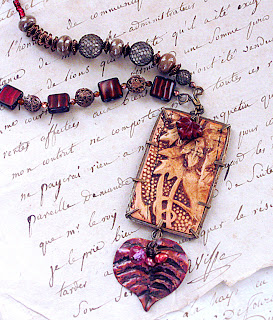One of the things that is most troublesome to me is my tendency to collect detritus and keep it in little containers all over my bench. Pieces of previous work that didn't quite make it, creative accidents, orphan beads, pieces of small repoussé work that my husband, Douglas, has made for me, interesting found objects, rocks with nifty textures, rusty bits, twigs-- all of these find a home in various receptacles. Sometimes I feel more like a 19th century naturalist, surrounded by specimens.
As I'm about to transform this space into a real working studio, I find myself firmly resolving to corral the clutter and keep my space zen-like and receptive to the slightest nudge from my Muse. But just this week, while digging through one of my boxes, I discovered a shard of polymer, a sample for the Jane Eyre cuff in faux ivory that I did some months ago.
Faux ivory cuff sample
Jane Eyre cuff
It was too large to make into a pendant so there it sat. I just enjoyed looking at it. I like making pieces that look as though they are shards discovered in an archaeological dig and then combine them with more modern elements into one whole. The juxtaposition of ancient and contemporary creates a tension that appeals to me. I just happened to have one of Objects and Elements' open bezels in the same box-- sometimes when I buy new findings I don't want to store them away since I tend to forget about them. If I leave them out on my bench, I see them every day and eventually find a use for them. I've used these bezels with several pieces, like the Dance of the Ancients.
Dance of the Ancients
Intrepid explorer of the artistic landscape that I am, this rectangular bezel was cut, shortened and re-shaped to fit a scrap piece of polymer that I carved a bit and antiqued. So the bezel was fit to the shard, instead of the opposite!
Relic pendant
The shard was long and rectangular so would allow me to keep some of best motifs. I carefully scored the polymer with an X-acto knife and kept making shallow slices until I could break it off without damage. Some additional cutting and sanding was necessary to make it fit the bezel and then I re-stained the edges with shoe polish. My plan was to make a simple pendant necklace I could wear with jeans and a tee. Yeah, well.
The bezel had two attachment loops so I decided to look through my stash for a suitable dangle. Sitting in one of my containers was a copper leaf that Douglas had done in repoussé and I had heat-patinated to a beautiful purple/copper sheen. I drilled a hole and attached that to the bottom loop. The leaf was a more modern style than the shard but I encouraged that by stringing some garnet-colored square Czech glass beads together with mesh-covered crystal beads interspersed with lampwork rounds. I tried several ideas for the bail, like a piece of brass from a mantle clock that I had taken apart but ended up making one out of 18 gauge bronze wire. For the clasp, I used an antique etched brass bead on a chain with a handmade shepherd's crook as the loop side. It worked perfectly and was very secure.
Sonata necklace
After completing the piece, I was a bit sad that the repoussé leaf might be leaving my workbench forever-- the fate of all one-of-a-kind pieces. So I thought “why not make a mold from that great little leaf” and got out my Alley Goop RTV (room temperature vulcanizing) putty, and made a mold. I had some scrap clay in a mix of burgundy, green and purple so I used that for the leaf, which turned out to be the perfect base color and added some Jacquard metallic powders and metallic acrylic paint for the copper accents. Maybe earrings to match?
Repoussé leaf
Polymer copies of repoussé leaf
So, at the end of the day, I say – keep it but organize it. You never know what treasures you'll find to inspire you at the bottom of your personal benchtop midden.



















